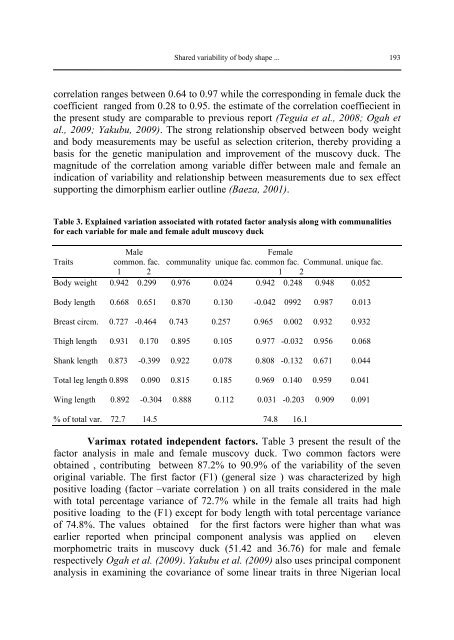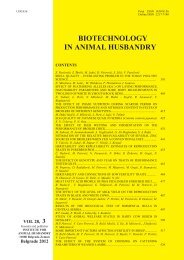Biotechnology in Animal Husbandry - Institut za Stočarstvo
Biotechnology in Animal Husbandry - Institut za Stočarstvo
Biotechnology in Animal Husbandry - Institut za Stočarstvo
You also want an ePaper? Increase the reach of your titles
YUMPU automatically turns print PDFs into web optimized ePapers that Google loves.
Shared variability of body shape ...<br />
correlation ranges between 0.64 to 0.97 while the correspond<strong>in</strong>g <strong>in</strong> female duck the<br />
coefficient ranged from 0.28 to 0.95. the estimate of the correlation coeffiecient <strong>in</strong><br />
the present study are comparable to previous report (Teguia et al., 2008; Ogah et<br />
al., 2009; Yakubu, 2009). The strong relationship observed between body weight<br />
and body measurements may be useful as selection criterion, thereby provid<strong>in</strong>g a<br />
basis for the genetic manipulation and improvement of the muscovy duck. The<br />
magnitude of the correlation among variable differ between male and female an<br />
<strong>in</strong>dication of variability and relationship between measurements due to sex effect<br />
support<strong>in</strong>g the dimorphism earlier outl<strong>in</strong>e (Bae<strong>za</strong>, 2001).<br />
Table 3. Expla<strong>in</strong>ed variation associated with rotated factor analysis along with communalities<br />
for each variable for male and female adult muscovy duck<br />
Male Female<br />
Traits common. fac. communality unique fac. common fac. Communal. unique fac.<br />
1 2 1 2<br />
Body weight 0.942 0.299 0.976 0.024 0.942 0.248 0.948 0.052<br />
Body length 0.668 0.651 0.870 0.130 -0.042 0992 0.987 0.013<br />
Breast circm. 0.727 -0.464 0.743 0.257 0.965 0.002 0.932 0.932<br />
Thigh length 0.931 0.170 0.895 0.105 0.977 -0.032 0.956 0.068<br />
Shank length 0.873 -0.399 0.922 0.078 0.808 -0.132 0.671 0.044<br />
Total leg length 0.898 0.090 0.815 0.185 0.969 0.140 0.959 0.041<br />
W<strong>in</strong>g length 0.892 -0.304 0.888 0.112 0.031 -0.203 0.909 0.091<br />
% of total var. 72.7 14.5 74.8 16.1<br />
Varimax rotated <strong>in</strong>dependent factors. Table 3 present the result of the<br />
factor analysis <strong>in</strong> male and female muscovy duck. Two common factors were<br />
obta<strong>in</strong>ed , contribut<strong>in</strong>g between 87.2% to 90.9% of the variability of the seven<br />
orig<strong>in</strong>al variable. The first factor (F1) (general size ) was characterized by high<br />
positive load<strong>in</strong>g (factor –variate correlation ) on all traits considered <strong>in</strong> the male<br />
with total percentage variance of 72.7% while <strong>in</strong> the female all traits had high<br />
positive load<strong>in</strong>g to the (F1) except for body length with total percentage variance<br />
of 74.8%. The values obta<strong>in</strong>ed for the first factors were higher than what was<br />
earlier reported when pr<strong>in</strong>cipal component analysis was applied on eleven<br />
morphometric traits <strong>in</strong> muscovy duck (51.42 and 36.76) for male and female<br />
respectively Ogah et al. (2009). Yakubu et al. (2009) also uses pr<strong>in</strong>cipal component<br />
analysis <strong>in</strong> exam<strong>in</strong><strong>in</strong>g the covariance of some l<strong>in</strong>ear traits <strong>in</strong> three Nigerian local<br />
193




